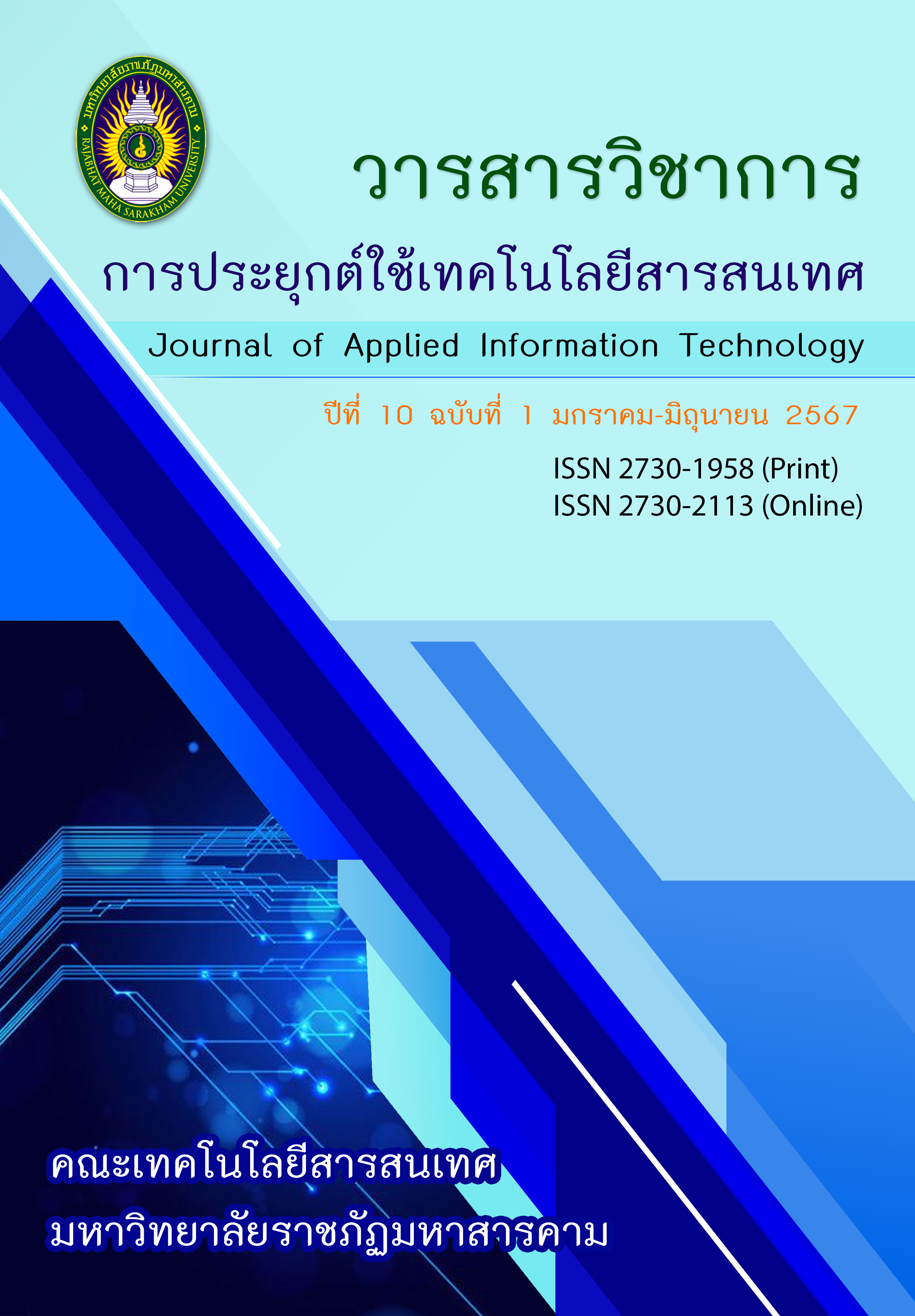Comparing the efficiency of models for cervical cancer screening การเปรียบเทียบประสิทธิภาพตัวแบบสำหรับการคัดกรองผู้ป่วยมะเร็งปากมดลูก
Main Article Content
Abstract
ABSTRACT
This research aims to improve the efficiency of models for cervical cancer screening. The data used in the study consists of cervical cancer patient data collected by Kelwin Fernandes, Jaime S. Cardoso, and Jessica Fernandes from Universidad Central de Venezuela, and is available on the website www.data.world.com. This data was then analyzed using the standard data mining process (CRISP-DM) with four classification techniques: Naïve Bayes, K-Nearest Neighbors, Decision Tree, and Random Forest. Performance metrics for data classification included Accuracy, F-measure, Sensitivity, and Specificity. The test results revealed that the Decision Tree technique is the most suitable for building a model for cervical cancer screening, achieving the highest accuracy of 96.62%, an overall F-measure of 76.93%, a sensitivity of 87.50%, and a specificity of 97.26%.
Article Details
References
เอกสารอ้างอิง
โรงพยาบาลศิริราช ปิยมหาราชการุณย์. (ม.ป.ป.). มะเร็งปากมดลูก ป้องกันด้วยวัคซีน HPV. https://www.siphhospital.com/th/news/article/share/476
medparkhospital. (2563). โรคมะเร็งปากมดลูก. Https://www.medparkhospital.Com.
Sahu, V., Chaturvedi, R., Singh, K., & Scholar, P. G. (n.d.). A Review on Divergent Application Architecture of Big Data Mining in Healthcare. https://doi.org/10.32628/IJSRCSEIT
Khan, I., Pakhtunkhwa, K., & Nadeem, M. (2023). Data Mining in Healthcare: Applying Data Mining and Machine Learning Techniques to Analyze Large Healthcare Datasets, Such as Electronic Health Records, For Improved Diagnosis, Treatment, and Patient Outcomes. Indus Journal of Science, 1(01), 20–26. https://induspublishers.com/IJS/article/view/15
Fernandes, K., Chicco, D., Cardoso, J. S., & Fernandes, J. (2018). Supervised deep learning embeddings for the prediction of cervical cancer diagnosis. PeerJ. Computer Science, 4(5). https://doi.org/10.7717/PEERJ-CS.154
William, W., Ware, A., Basaza-Ejiri, A. H., & Obungoloch, J. (2018). A review of image analysis and machine learning techniques for automated cervical cancer screening from pap-smear images. Computer Methods and Programs in Biomedicine, 164, 15–22. https://doi.org/10.1016/J.CMPB.2018.05.034
Ji, M., Zhong, J., Xue, R., Su, W., Kong, Y., Fei, Y., Ma, J., Wang, Y., & Mi, L. (2022). Early Detection of Cervical Cancer by Fluorescence Lifetime Imaging Microscopy Combined with Unsupervised Machine Learning. International Journal of Molecular Sciences, 23(19), 11476. https://doi.org/10.3390/IJMS231911476/S1
Aljrees, T. (2024). Improving prediction of cervical cancer using KNN imputer and multi-model ensemble learning. PLOS ONE, 19(1), e0295632. https://doi.org/10.1371/JOURNAL.PONE.0295632
Karamti, H., Alharthi, R., Anizi, A. Al, Alhebshi, R. M., Eshmawi, A. A., Alsubai, S., & Umer, M. (2023). Improving Prediction of Cervical Cancer Using KNN Imputed SMOTE Features and Multi-Model Ensemble Learning Approach. Cancers 2023, Cancers 2023, 15(17), 4412; https://doi.org/10.3390/cancers15174412
Narayan, S. R. S. V., & Rose, R. J. (2022). Cervical Cancer Detection Based on Novel Decision Tree Approach. Computer Systems Science and Engineering, 44(2), 1025–1038. https://doi.org/10.32604/CSSE.2023.022564
Devi, S., Gaikwad, S. R., & Harikrishnan, R. (2023). Prediction and Detection of Cervical Malignancy Using Machine Learning Models. Asian Pacific Journal of Cancer Prevention : APJCP, 24(4), 1419. https://doi.org/10.31557/APJCP.2023.24.4.1419
Rawat, P., Bajaj, M., Mehta, S., Sharma, V., & Vats, S. (2023). A Study on Cervical Cancer Prediction using Various Machine Learning Approaches. International Conference on Innovative Data Communication Technologies and Application, ICIDCA 2023 - Proceedings, 1101–1107. https://doi.org/10.1109/ICIDCA56705.2023.10099493
rivastav, S., Guleria, K., & Sharma, S. (2023, March 15-17)Predictive Machine Learning Approaches for Cervical Cancer Detection: An Analytical Comparison. 10th International Conference on Computing for Sustainable Global Development (INDIACom), New Delhi, India. https://ieeexplore.ieee.org/document/10112553
Ganguly, T., Pati, P. B., Deepa, K., Singh, T., & Ozer, T. (2023). Machine Learning based Comparative Analysis of Cervical Cancer Risk Classifications Algorithms. Proceedings of the 2nd IEEE International Conference on Advances in Computing, Communication and Applied Informatics, ACCAI 2023. https://doi.org/10.1109/ACCAI58221.2023.10200617
Jha, A. K., Mithun, S., Sherkhane, U. B., Jaiswar, V., Osong, B., Purandare, N., Kannan, S., Prabhash, K., Gupta, S., Vanneste, B., Rangarajan, V., Dekker, A., & Wee, L. (2023). Systematic review and meta-analysis of prediction models used in cervical cancer. Artificial Intelligence in Medicine, 139. https://doi.org/10.1016/J.ARTMED.2023.102549
Rodríguez, J. D., Pérez, A., & Lozano, J. A. (2010). Sensitivity Analysis of k-Fold Cross Validation in Prediction Error Estimation. IEEE Transactions on Pattern Analysis and Machine Intelligence, 32(3), 569–575. https://doi.org/10.1109/TPAMI.2009.187
Refaeilzadeh, P., Tang, L., & Liu, H. (2009). Cross-Validation. Encyclopedia of Database Systems, 532–538. https://doi.org/10.1007/978-0-387-39940-9_565
Zhang, Z., Zhao, Y., Liao, X., Shi, W., Li, K., Zou, Q., & Peng, S. (2019). Deep learning in omics: A survey and guideline. Briefings in Functional Genomics, 18(1), 41–57. https://doi.org/10.1093/BFGP/ELY030
Ertuğrul, Ö. F., & Tağluk, M. E. (2017). A novel version of k nearest neighbor: Dependent nearest neighbor. Applied Soft Computing Journal, 55, 480–490. https://doi.org/10.1016/J.ASOC.2017.02.020
Custode, L. L., & Iacca, G. (2023). Evolutionary Learning of Interpretable Decision Trees. IEEE Access, 11, 6169–6184. https://doi.org/10.1109/ACCESS.2023.3236260
Shaikhina, T., Lowe, D., Daga, S., Briggs, D., Higgins, R., & Khovanova, N. (2019). Decision tree and random forest models for outcome prediction in antibody incompatible kidney transplantation. Biomedical Signal Processing and Control, 52, 456–462. https://doi.org/10.1016/J.BSPC.2017.01.012
Fernandes, K., S Cardoso, J., & Fernandes, J. (2560). Cervical cancer. Http://www.Data.World.
Martinez-Plumed, F., Contreras-Ochando, L., Ferri, C., Hernandez-Orallo, J., Kull, M., Lachiche, N., Ramirez-Quintana, M. J., & Flach, P. (2021). CRISP-DM Twenty Years Later: From Data Mining Processes to Data Science Trajectories. IEEE Transactions on Knowledge and Data Engineering, 33(8), 3048–3061. https://doi.org/10.1109/TKDE.2019.2962680
Kowsari, K., Meimandi, K. J., Heidarysafa, M., Mendu, S., Barnes, L., & Brown, D. (2019). Text Classification Algorithms: A Survey. Information 2019, 10(4), 150. https://doi.org/10.3390/INFO10040150
Tharwat, A. (2018). Classification assessment methods. Applied Computing and Informatics, 17(1), 168–192. https://doi.org/10.1016/J.ACI.2018.08.003/FULL/PDF
Jawakar. (2020, Mar 1). Why You Need CRISP-DM for Data Science?. https://medium.com/@jawakarselvavinayagam/why-you-need-crisp-dm-for-data-science-a789a5ebb900
อนุพงศ์ สุขประเสริฐ. (2566). การทำเหมืองข้อมูลด้วยโปรแกรม RapidMiner Studio (5th ed.). มหาวิทยาลัยมหาสารคาม.
Sammut, C., & Webb, G. I. (Eds.). (2017). Random Forests. In Encyclopedia of Machine Learning and Data Mining (p. 1054). Springer US. https://doi.org/10.1007/978-1-4899-7687-1_695
Nithya, B., & Ilango, V. (2018). Predictive analytics in health care using machine learning tools and techniques. Proceedings of the 2017 International Conference on Intelligent Computing and Control Systems, ICICCS 2017, 2018-January, 492–499. https://doi.org/10.1109/ICCONS.2017.8250771
Reisman, M. (2017). EHRs: The Challenge of Making Electronic Data Usable and Interoperable. Pharmacy and Therapeutics, 42(9):572-575. https://pubmed.ncbi.nlm.nih.gov/28890644
Loh, H. W., Ooi, C. P., Seoni, S., Barua, P. D., Molinari, F., & Acharya, U. R. (2022). Application of explainable artificial intelligence for healthcare: A systematic review of the last decade (2011–2022). Computer Methods and Programs in Biomedicine, 226, 107161. https://doi.org/10.1016/J.CMPB.2022.107161


